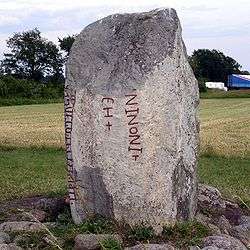Karlevi Runestone
Coordinates: 56°37′N 16°27′E / 56.61°N 16.45°E

The Karlevi Runestone, designated as Öl 1 by Rundata, is commonly dated to the late 10th century[1] and located near the Kalmarsund straight in Karlevi on the island of Öland, Sweden. It is one of the most notable and prominent runestones and constitutes the oldest record of a stanza of skaldic verse.[2]
Description
The runic inscription on the Karlevi Runestone is partly in prose, partly in verse. It is the only example of a complete scaldic stanza preserved on a runestone and is composed in the "lordly meter" the dróttkvætt.[3] It is notable for mentioning Thor's daughter Þrúðr and Viðurr, one of the names for Odin, in kennings for "chieftain." In the second half of the stanza a reference is made to Denmark, but it is not clear what exactly this means in this poetic context.[1]
The stone is contemporary with the Battle of the Fýrisvellir and it is consequently possible that the stone was raised by warriors who partook in it, in memory of their lord.[4]
The inscription, which is on a granite stone that is 1.4 meters in height, is classified as being in runestone style RAK. This is the classification with inscriptions with runic text in bands that have no attached dragon or serpent heads and the ends of the runic bands are straight. The non-runic inscription on the reverse side appears to be accompanied by a small Christian cross and a Norse pagan Thor's hammer, or Mjöllnir. Other surviving runestones or inscriptions depicting Thor's hammer include runestones U 1161 in Altuna, Sö 86 in Åby, Sö 111 in Stenkvista, Sö 140 in Jursta, Vg 113 in Lärkegapet, DR 26 in Laeborg, DR 48 in Hanning, DR 120 in Spentrup, and DR 331 in Gårdstånga.[5][6]
Inscription
Transliteration of the runes into Latin characters:
- + s-a... --(s)- i(a)s * satr * aiftir * si(b)(a) * kuþa * sun * fultars * in hons ** liþi * sati * at * u * -ausa-þ-... +: fulkin : likr : hins : fulkþu : flaistr (:)* uisi * þat * maistar * taiþir : tulka * þruþar : traukr : i : þaimsi * huki * munat : raiþ:uiþur : raþa : ruk:starkr * i * tanmarku : --ntils : iarmun**kruntar : urkrontari : lonti[7]
S[t]æ[inn] [sa]s[i] es sattr æftiʀ Sibba Goða, sun Fuldars, en hans liði satti at ... ...
|
This stone is set up in memory of Sibbi Góði/Goði, son of Foldarr, and his retinue set on ...
|
This stone is placed in memory of Sibbi the good, Fuldarr's son, and his retinue placed on ... ...
|
A more idiomatic English translation of the poetic stanza is provided by Foote & Wilson:
- Tree of Thrúd of hostilities, the man whom the greatest virtues accompanied - most men know that - lies buried in this mound; a more upright chariot-Vidur of wondrous-wide ground of Endil will not rule, strife-strong, land in Denmark.[8]
The reverse side of the stone also has a non-runic inscription In nomin[e] (?) Ie[su] (?) which may mean "In the name of Jesus."[7]
Notes
- 1 2 Zilmer, Kristel (2005). ""He Drowned in Holmr's Sea": Baltic Traffic in Early Nordic Sources" (PDF). Tartu University Press: 76–80. ISBN 9949-11-089-0.
- ↑ Quinn, Judy (2000). "From Orality to Literacy in Medieval Iceland". In Ross, Margaret Clunies. Old Icelandic Literature and Society. Cambridge University Press. p. 43. ISBN 0-521-63112-2.
- ↑ Jesch, Judith (2001). Ships and Men in the Late Viking Age: The Vocabulary of Runic Inscriptions and Skaldic Verse. Boydell Press. pp. 9–11. ISBN 0-85115-826-9.
- ↑ The article Karlevistenen in Nordisk familjebok (1910).
- ↑ Holtgård, Anders (1998). "Runeninschriften und Runendenkmäler als Quellen der Religionsgeschichte". In Düwel, Klaus; Nowak, Sean. Runeninschriften als Quellen Interdisziplinärer Forschung: Abhandlungen des Vierten Internationalen Symposiums über Runen und Runeninschriften in Göttingen vom 4-9 August 1995. Berlin: Walter de Gruyter. p. 727. ISBN 3-11-015455-2.
- ↑ McKinnell, John; Simek, Rudolf; Düwel, Klaus (2004). "Gods and Mythological Beings in the Younger Futhark". Runes, Magic and Religion: A Sourcebook (PDF). Vienna: Fassbaender. pp. 116–133. ISBN 3-900538-81-6.
- 1 2 3 Project Samnordisk Runtextdatabas Svensk - Rundata entry for Öl 1.
- ↑ Foote & Wilson, p. 329.
External links
- A presentation with pictures at the Foteviken Museum website.
Bibliography
- Foote, Peter & Wilson, David M.: The Viking Achievement. 1989 ISBN 0-283-97926-7.
- Jansson Sven B. F.: Runinskrifter i Sverige. 1984. 201 pages.
- Salberger, Evert: "Dedikationen på Karlevi-Stenen, Mansnamn och Versform." Sydsvenska Ortnamnssällskapets Årsskrift 1997. pp. 88-115.
- Strid, Jan Paul: Runstenar. Malmö 1991. 119 pages.
- Söderberg, Sven: Sveriges Runinskrifter. Bd 1, "Ölands Runinskrifter." Stockholm 1900-1906.